In the Special Collections Library, we are always excited when our students and faculty connect to the unique and rare materials in our collections. Please enjoy this guest blog post by students in Professor Ruth Behar's course, "Cuba and Its Diaspora." This is the second post in this guest series, the first post can be found here. The class visited our teaching space to engage with Cuban book artist, Rolando Estévez and Professor Behar as they guided the group through the amazing world of Cuban artists' books. Professor Behar is Victor Haim Parera Collegiate Professor of Anthropology.
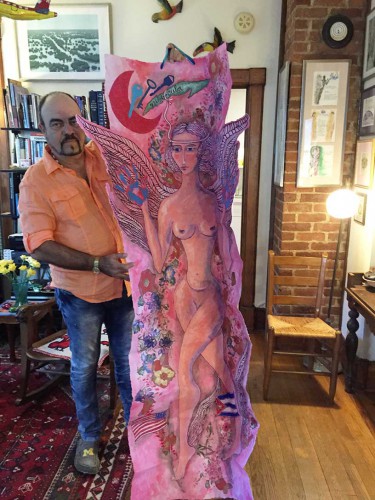
Rolando Estévez presenting image from The Key to the House/La llave de la casa. Bilingual edition (Spanish and English). Produced in Matanzas, Cuba, June-September 2015. Ruth Behar (author) and Rolando Estévez (illustrator and designer).
There are rare moments when higher education overlaps with artistic expressions, when academic education intersects with cultural production. The careers and collaborations of Dr. Ruth Behar and long time friend and Cuban artist Rolando Estévez Jordán have fostered many of those moments for countless students.
As many know, Dr. Behar is a professor at the University of Michigan’s anthropology department and her passion can be found at the intersections of anthropology and cultural expressions. Intrinsically linked, these connections are expressed vigorously in her pedagogy and her commitment to teaching. Similarly, Estévez’s artistic expression, that includes yet goes beyond conventional artistic forms such as painting and poetry, displays pieces and exhibits that offer deep insights into the inner workings of Cuban society. Rather then keeping his talents to himself, Estévez has graciously dedicated himself to instructing others in basic freestyle design, theatre design, and bookmaking.
Most recently Estévez’s “Plurality of Love: Poetry and Art in the Works of Cuban Artist Rolando Estévez” offered an exhibit that featured his new handmade book art. It also included events like an art book workshop and cafecito and lecture with Estévez and Dr. Behar. Together Estévez and Dr. Behar organized the events surrounding Estévez’s exhibit and week four of Behar’s course “Cuba and Its Diaspora” in ways that created extraordinary opportunities for students in her course.
Initially the course reads like any other: an exploratory introductory course on the history and culture of a foreign nation -- in this case Cuba since the Revolution of 1959.
However, the course displays a commitment to not only academic scholarship but also a cultural experiential teaching style that exposed the class to classic Cuban revolutionary cinema, dancing lessons, and Cuban literature and music.
Those experiences went far beyond the pages of our texts and hit a crescendo with Estévez’s visit. As one student, Shalini Rao, so eloquently phrased it, Estévez’s presence “brought the Cuban story out of the pages and into real life.” What follows are the accounts of those students, including myself, on Estévez’s visits to our class and the workshop he led in the art of bookmaking.
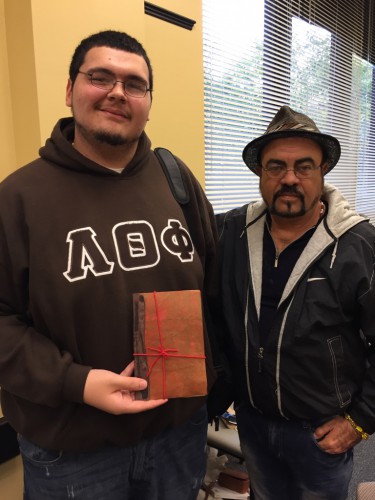
Student with Cuban book artist, Rolando Estévez
“Estévez, while on campus, exhibited an aura of a creative artist that was quite unique. When I had the pleasure of sharing a class period with him, some of his ruminations on a ‘need to create’ struck a chord with me. He described his need to create as being ‘en mi sangre’, or ‘in my blood’. This foundational desire to create helped me better understand the motivations behind his work. Estévez brought a quiet but powerful passion for his art, and it was very inspiring to see inside the mind of an artist of his caliber.”
-Thomas Kramer
“Interacting with Rolando Estevez truly brought to life the struggles experienced by Cubans who remained on the island under Castro’s regime. Before meeting and listening to Estevez, the extent of my knowledge of how the revolution truly impacted people was limited to decades-old readings and films. The people and lives I read about could have easily been characters in a distant world. Hearing Estevez discuss being kicked out of university for anti-regime opinions, and seeing how his own professional and personal life had been impacted by the regime’s oppression brought the Cuban story out of the pages and into real life.”
- Shalini Rao
“It was a truly wonderful experience having Rolando Estévez on campus and in our class. Not only did he give us a glimpse into his world and life as an artist but he shared his personal stories with us and interacted with us in such a warm, humble, and open manner. He allowed us to finger through the pages of his hand-made books ourselves, allowing us to immerse ourselves in his masterpieces instead of having to ‘admire at a distance’ as most artists would do. As a Cuban-American whose family has been emigrating from Cuba over the last fifty years, I personally very much appreciated and was touched by hearing the stories and struggles of someone who has remained en la isla.”
– Elizabeth “Isabel” Batista
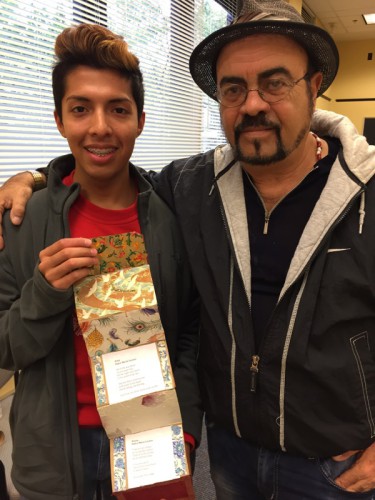
Student with Cuban book artist, Rolando Estévez
Those stories and struggle are forever archived here at the University of Michigan due to the gracious donations of Estévez, the efforts of Dr. Behar and the hard work of the librarians and archivists at the Hatcher Graduate Library. Estévez’s handmade book arts are not only storied in out Special Collections and displayed in his newest exhibit, but have been passed down to eager students. Continuing in that tradition, which he helped begin, Estévez led a workshop for Michigan students on the art of bookmaking.
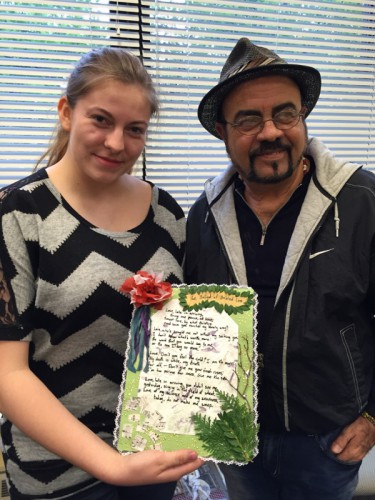
Student with Cuban book artist, Rolando Estévez
“My favorite part of Estévez’s visit to the University of Michigan was the book-making workshop he held. I am not particularly artistic myself so I had many doubts going into the art session. However, I found that Estévez’s approach and direction to guide the workshop was very beneficial. Initially he provided a few templates that participants could work with to begin making the book. Nevertheless, Estévez made sure that we should fully commit to our own artistic and personal expression on how we wanted our book to be made. Even when a lot of people, including myself, asked for recommendations or tips on their crafted pieces, Estévez was there to help. Overall I really enjoyed the event and hope that Professor Ruth Behar can continue to invite Estévez to campus so more people can learn about his unique art.”
- Rogelio Castro
“I had the pleasure of attending Rolando Estevez’s artist book workshop. The way in which he described the process of making an artist book was enlightening. For each of his books and pieces of art he has a theme, or a passage, to stay true to. However, beyond that, everything is free to work on one’s own interpretation. He is a master at making individually different elements work as a cohesive pair and finding the beauty in the world’s imperfection.”
–Ashton Strother
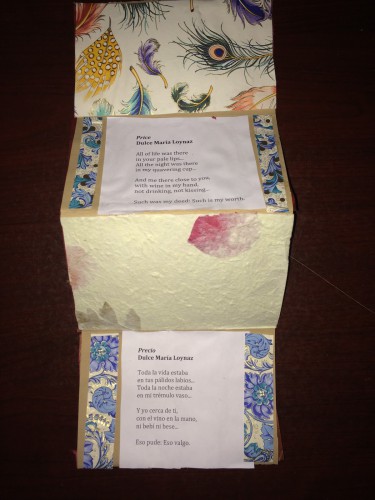
“I attended Estévez’s workshop and can best describe the experience as something as both collaborative yet individual at the same time. Estévez provided us with important and unique inspiration from his own work, which furthermore connected all of our creations with a common thread as we worked stylistically in a similar manner to his. From there, however, everyone was encouraged to interpret the various poems in their own way to create something distinctive and irreplaceable, much like Estévez’s own works. No book is ever exactly the same: each uses unique materials to convey and embody the specific message of a piece. As someone who rarely creates art, I really enjoyed and appreciated the creativity I could explore in the workshop with the overarching guidance and influence of Estévez’s unique style.”
- Ava Tavrazich
From attending these events and reading these responses one gets the sense that these experiences will endure with these students – I can say the same about myself. Coupled with the many lessons learned within our classroom, the students of Dr. Behar walk away with an extraordinary exposure to Cuban culture and history – an experience that could only be rivaled by actually travelling to the island, which Dr. Behar has done in the past with University of Michigan students.
These experiences and the lessons within our classroom are invaluable because false information is frequently circulated about Cuba and even today polemics tend to dominate discussions. Together Estévez and Dr. Behar work to help move the discussion far beyond reductive polemics, because Cuba is far more than US-Cuba antagonisms.
Blog post by Richard Mwakasege-Minaya, Thomas Kramer, Shalini Rao, Elizabeth “Isabel” Batista, Rogelio Castro, Ashton Strother, and Ava Tavrazich. All photos within this post are by Professor Ruth Behar.